 Armchair Genealogy
Armchair Genealogy
By
Melinda Cohenour
Romance is in our Heritage
February 1, 2016
February. A month of contrasts. Often the coldest month of the year in the Southwest, biting cold weather hastened in by the Blue Norther a blast directly from the frigid Arctic continent; and, conversely, many times the harbinger of Spring, when southerly breezes from the tropics rush northwesterly bringing warm, sunny days and a taste for those first brilliant green sprigs on the trees interspersed with buds soon to burst forth in full flower. Romantic thoughts. Fitting for what may well be our most romantic month: February – the month we celebrate St. Valentine’s Day.
My father was a romantic. Proof of his innate romanticism was shown not only by his proposal of marriage to my mother on Valentine’s Day, but decades later his service as a lay minister to hear the vows of my beloved Rod and myself when those fickle February winds had blown from the north and brought an icy wasteland to our shared home in Yonder Hills outside Guthrie, Oklahoma. For Rod and I had intended to wed on Valentine’s Day but were prevented from traveling to Dallas for that to take place. Daddy Jack, a deacon of the Baptist Church, a teacher of youth in that church, a devout and Godly man offered to hear our vows and organized a wedding for us that preceded our formal church vows five days later that month, the 19th, before Brother Steve Leatherwood who had served as our pastor in Dallas for many years.
Fitting that Daddy would be the romantic. He loved Gothic romances, always enjoying the final emergence of true love that would not be denied. He could sometimes be caught with a tear in his eye (“just a spot of dust”) as he read the final pages. He always remembered our mother’s birthday and Mother’s Day. One of my cherished heirlooms is the set of Lovebird dishes he bought for her to commemorate one of their anniversaries. And I treasure the pair of hand painted China lamps bearing a medallion of roses ringed about with gilt. The lamps were so expensive he had to ask the merchant jeweler in our hometown to keep them for him in secret as he paid off the remaining balance. (This from the man who traditionally paid cash for his new cars! He really wanted Mom to have those lamps!) He gave one to her on her birthday and the second on Mother’s Day. Not as bad as one might think since her birthday was the 7th of May which oft-times also shared the holiday.
So, it really came as no big surprise as I researched Daddy’s line that I would find two of the most romantic stories connected to his male ancestors. My 8th great-grandfather Bartholomew DuPuy distinguished himself in service to King Louis XIV of France. In my research into Bartholomew DuPuy, I found numerous stories.
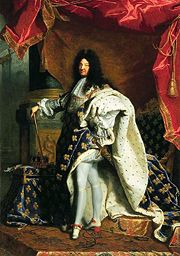
King Louis XIV
I even purchased a bound book written by another descendant/family historian that recounted this version of the exciting and romantic story of Bartholomew’s escape from certain imprisonment and/or death in order to stand firm in his religious beliefs:
Old Churches, Ministers, and Families of Virginia.
Article LXIII.
"From notes written at the base of our ancestral tree I copy the following:
--'Bartholomew Dupuy (my paternal Huguenot ancestor) in 1650 or 1653. At eighteen years of age he entered the army, where his intelligence and fidelity soon won him the confidence of the King, Louis XIV, who promoted him at an early age to be an officer in his household guard. He so far trusted and honoured him as often to select him to perform duties so important as to require his own signature to some of the orders. One of these papers was the means under God of saving this officer and his wife from arrest and most probably from death.
But a short time before the revocation of the Edict of Nantes, he married a Countess (Susannah Lavillon) and retired to his villa for a short respite from his military duties. Very soon after his retirement, they were called on by one of the King's messengers, who communicated the startling intelligence that the revocation of the Edict of Nantes was to take immediate effect, and that he had been sent by the King from motives of esteem to save him and his wife from the impending fate of all heretics. He urged their submission (that is, their renunciation of the Protestant faith) with all his eloquence, and with all his promises of great benefits from the King if they would show them fidelity by obeying their orders.
Dupuy replied that the demand was so sudden and important that he would beg a few hours for consideration. The priest said that this request was reasonable, and he would grant it cheerfully. As soon as he had retired, Dupuy sent for the village tailor, and asked whether he could have a suit of livery made for his page in six hours. He replied in the affirmative, and at midnight they were completed and delivered. In this suit he immediately disguised his wife as his page, and putting on his best uniform, and girding on his sword, took what money and jewels they had, together with a few clothes and their Bibles and Psalm-Books, and, mounting two good horses, set out for the frontier of the kingdom.
They travelled either fourteen or eighteen days, and, though stopped almost daily, always escaped by saying that he was the King's officer, until near the line, when he was arrested. He showed the officer the paper with the King's signature; and, immediately snatching it back, he drew his sword and fiercely asked by what authority he was thus insulted, and demanding an escort for his protection to the line, which was immediately granted. On their safe arrival the guard was dismissed, and, crossing over into Germany, they there sang the praises of God in the fortieth Psalm, and offered up prayers and thanksgivings to their great Deliverer for their escape from a cruel death.
They remained in Germany fourteen years, then stayed two years in England, from whence they came to America in the year 1700, and settled at Manakintown, on James River, in King William parish.
The sword used by Bartholomew Dupuy while in France is now in possession of Dr. John James Dupuy, of Prince George, and was used by his grandfather, James Dupuy, Sr., of Nottoway, at the battle of Guilford, where he signalized himself.' "
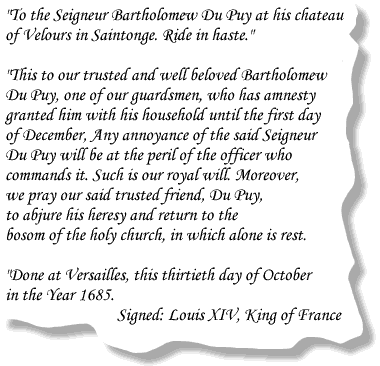
|
|
Photo of the note written by the King as it was, supposedly, saved by the Trabue family (descendants also of DuPuy who also had the sword - no pic of sword.)
We are related to Bartholomew DuPuy by the following descendancy: Bartholomew (or Bartholomey) DuPuy (1652-1743) had a son, Pierre “Peter” DuPuy, Sr. (1694-1773), whose son Pierre “Peter” DuPuy, Jr. (1729-1812) had a daughter, Mary A. Malone DuPuy (1766-1851) who married David Motley Ellington (1759-1855). Mary and David Ellington had a daughter Prudence Ellington (1788-1860) who married Peyton Wade (1808-1887. Their daughter, Martha Ann Wade (1847-1886) would marry Absalom Creek (1844-1914) (the son of Virginia Lee Younger and Jacob Haudenscheldt Creek. Their daughter Flutie Creek (1877-1951) would grow up to marry Lewis Wallace “Wall” Alexander (1862-1941) and bear one child, Nora Viola Alexander (1896-1964). Nora married Everett Marion Carroll (1894-1981) and they had one son, John Edward “Jack” Carroll (1913-1996), our father – my DaddyJack.
The second story found in researching my father’s line concerned a German ancestor, George F. Hempleman. Now, this was an interesting and long-awaited find. My grandmother, Nora Alexander King (married name) would use this heritage to reprove her granddaughters when we were behaving like little tomboys rather than young ladies by remonstrating in a rather stern voice, “Remember, you are descended from Baron von Hempleman of Hesse-Cassel and should behave as ladies!” For years and years I searched for what I understood to be Baron von Hompellman or Hoppelman or Homperman for grandmother would use her Germanic accent to pronounce the name. I was actually rather surprised when, in seeking parents of yet another ancestral pair I found George Hempleman and realized my mistake. And this romantic story is also a doozy!
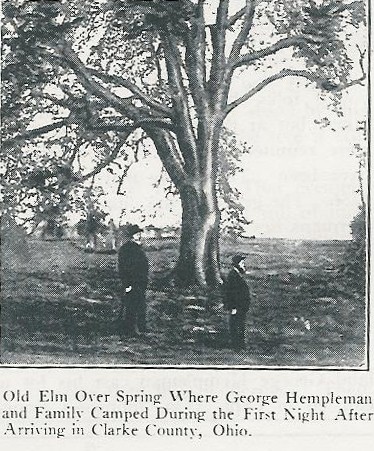
|
|
The story goes like this: George Hempleman, the younger son of Baron von Hempleman of Hesse-Cassel, and a member of the peerage became fully enamored of a young woman, Marguerite Duffey, the daughter of peasants. His father when he became aware of his young son’s romantic entanglement demanded that an immediate and complete halt be called to the relationship. George and Marguerite, however, were “head-over-heels” in love and no reprimand could cause their hearts to change and their attentions to cease. The father, by all accounts, was prone to dictatorial ways and both sons bristled at his officious and demanding ways. So, George shared with elder brother, Adam, the depths of his despondency regarding their father’s demands. Adam, it seemed, was already planning a way to free himself of his overbearing father. He planned to emigrate to the New World. When he shared this plan with George, it seemed to be the ready answer for the plight of the lovelorn pair.
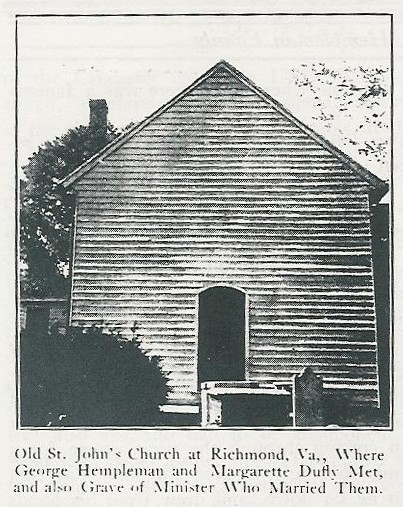
|
|
In short time, Adam, George, and Marguerite made their plans. In the absence of the Baron’s blessings, there was no means by which they could fund their adventure other than by selling themselves into a state of indenture in exchange for the price of their fare aboard the ship. Upon arrival, they were collected by their respective new masters and transported to the plantation where they would begin to pay off the debt.
A poem was written about this pair which I will provide here:
Our Noble Ancestors by Winifred Weaver Wilkinson
Read by author at annual Hempleman-Weaver Reunion
Springfield, OH Aug 12, 1914
From a frowning German castle
To an humble peasant’s cot.
Once Cupid sped an arrow
To the one of lowly lot;
But the unrelenting parent
Of that titled German boy
Sought to stay the hand of Cupid
Sought his visions to destroy.
“Blue blood shall not be mingled
With a lowly peasant strain!”
Declared that German scion
Of that house of ancient fame;
“You shall wed as I have chosen!”
Was the mandate of that lord,
Who ruled in Hesse-Cassel
By his word and by his sword.
Now the maiden, sweet and winsome,
Fair of hair and blue of eye,
Pledged her troth to the young noble -
Heart and hand, to live or die.
Did he give her up for title?
Money, land, and castles bare?
Leave her to some plodding peasant,
Just his common lot to share?
To his elder more-staid brother, {Adam}
Turned he in that hour of trial,
He who, too, had felt the burden
Of that rock-ribbed German style;
He had longed to cross the water,
“Why not come and go with me?
Bring your gentle, low-born maiden:
Marry her across the sea.”
These two youths and one lone maiden
Worked their way from place to place,
Reached the seaboard where they bartered
Future freedom with good grace.
They would take them ‘cross the waters,
In steerage they must ride:
And to pay for travel westward
They in bondage must abide.
They quaffed the cup to its bitter dregs!
When they reached the land of gold,
Forced onto the block with the nervous herd
And into slavery sold.
He to the Carolinas,
She to Virginia soil:
He with his soft hands hardened
With a pitiful life of toil:
Worn to tatters his shoes,
Fallen to rags his clothes,
Weary, overburdened and hunger
Were among his lesser woes;
Tortured by thoughts of her,
Alone, he knew not where;
Should her beauty be a curse
And her innocence a snare?
And she had never a word
Through all those years of woe;
“Will I find him true and waiting
Or has life yet a deeper blow?”
She had given up home and country:
“Oh! He cannot fail me now”’
She has served her time as a bound-maid,
“He’ll not forget his vow.”
Four long years of servitude,
Each in their separate sphere
Had brought to common equality
The maid and the titled peer.
Back, to the little church-house
Where they pledged in the end to meet;
Back, went Margarette Duffe
Her lover of years to greet;
She sat through many a service
With watchful eyes on the door,
Like her sex for generations
She could wait, but nothing more.
And just a few weeks later,
Back, to her side for life —
Whom she saw last a stripling
Grown a man hardened by strife.
And where later Patrick Henry
Gave that church immortal fame
Romance triumphed o’er hardships –
Margarette Duffe bore his name.
George Hempleman faced his future
With the long-sought maid of his choice,
May his sturdy brood inhabit the earth
And in him and his deeds rejoice.
He was our soldier-hero
Our source of glowing pride.
God grant us the courage and honor
He showed toward his promised bride.
May our boys place love before mammon
May our girls be as steadfast and true,
May the blood of our German ancestors
Inspire us to dare and to do
.
{Hempleman Family by George Whitefield}
This book by George Whitefield I also purchased to add to my genealogical library. The story is, indeed, a romantic tale which has been retold a number of ways. There was even a movie produced which used this tale as the basis for the hero and heroine’s own love story. And, although this is truly a tale of true love, I believe the story of the Hempleman brothers is worthy of relating here as well.
Adam Hempleman, the elder brother, was indentured to a plantation owner in Pennsylvania. After his term of indenture was paid, he first settled in Kentucky where he married and ultimately moved to Adams County, Ohio. George and Marguerite after their reunion and marriage had settled in Clark County, Ohio, by a complete quirk of fate (if you believe all such coincidences to be merely coincidental.) The brothers, who had each served their new country (*) during the Revolutionary War, had not seen one another since their arrival in the New World. Many decades had passed with no word being exchanged between them. George and his love, Marguerite had made plans to meet at the church but Adam and George had not made any such plans leaving their future to fate. In another tale related by descendant George Whitley, in his book, A History of the Hempleman Family in America, 1912, Higginson, authored by George Whiteley]:
“…by chance a neighbor of Adam Hempleman was traveling north and stopped with George Hempleman Jr., over night, remarked that there was a man in his county by the same name of Hempleman that resembled him very much and later George Hempleman, Sr., in the company with his son George, visited Adam Hempleman at his home in Adams County. What a reunion that must have been....... “
To my mind, that is the third most romantic tale I’ve uncovered in my travels through my family’s lineage – my armchair cruises that have provided me with stories as fabulous and enriching as any I might encounter in some library written about other people in other families.
We are related to George F. Hempleman in this manner: George F. Hempleman (1732-1842) married Marguerite Duffey and named a son George F. Hempleman, Jr. (1778-1853). George Hempleman, Jr. married Ruth Howell (1785-1825) and they had a daughter named Susan. Susan Hempleman (1806-1884) married Richard Alexander (1789-1857) and they named one of their sons George Hempleman Alexander (1830-1894). George H. Alexander married Margaret Lowe (1833-1921) and they had a son they named Lewis Wallace “Wall” Alexander who is noted above as the first husband of Flutie Creek. Their daughter, Nora Viola Alexander, was the mother of my father, John Edward “Jack” Carroll.
(*) Revolutionary service:
George was a private, 1781, in Capt. William Johnson's company, 10th battalion, Lancaster Co., PA [p.173] militia.
Adam was a private in Capt. Thomas Robinson’s company, 10th February 1781, raised in Northumberland Co., PA. [‘Pennsylvania in the War of the Revolution: battalions and line, 1775-1783; Vol. II, Muster rolls of ranging companies, etc., with lists of Pennsylvania pensioners in 1789 and 1813.’]
Researched and Compiled by author.
Click on author's byline for bio and list of other works published by Pencil Stubs Online.
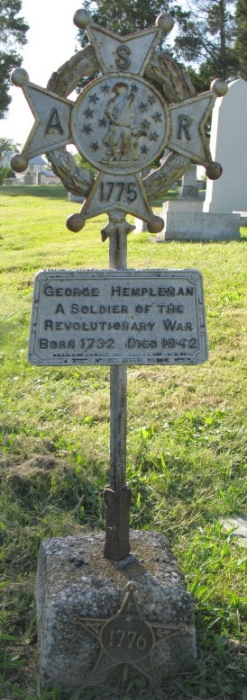
|








